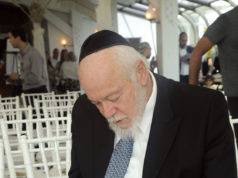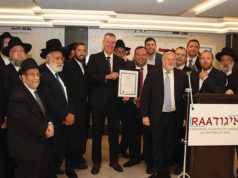 The idea of building a Jewish Museum in Greece (JMG) was first conceived in the 1970s by members of the Jewish community of Athens, who offered every kind of assistance towards the realization of this dream.
The idea of building a Jewish Museum in Greece (JMG) was first conceived in the 1970s by members of the Jewish community of Athens, who offered every kind of assistance towards the realization of this dream.
The Museum was established in 1977 and housed in a small room next to the city’s synagogue. It contained objects salvaged from World War II, artifacts, documents and manuscripts of the 19th and 20th centuries, and the jewelry of the Jews of Thrace that had been seized by the Bulgarians in 1943. The latter had been returned to the Greek government after the abdication of the Bulgarian king and the establishment of a communist regime in the country.
The following years saw a thorough and careful collection of material from all the communities of Greece, under the inspired guidance of Nikos Stavroulakis, director of the museum until 1993. The collection expanded with rare books and publications, textiles, jewelry, domestic and religious artifacts. The JMG soon began to attract the attention of many visitors, researchers and donors. As the museum’s collection grew and its activities expanded, it outgrew its home and a new one had to be found. In 1984, it moved to a rented space occupying the 3rd floor of 36 Amalias Avenue. The exhibition was reorganized into thematic units covering the interests of its various visitors.
The JMG soon began to attract the attention of many visitors, researchers and donors. As the museum’s collection grew and its activities expanded, it outgrew its home and a new one had to be found. In 1984, it moved to a rented space occupying the 3rd floor of 36 Amalias Avenue. The exhibition was reorganized into thematic units covering the interests of its various visitors.
During the following years the museum’s activities expanded, to include both the research and study of the Greek Jews in collaboration with other foundations and researchers from Greece and abroad. At the same time, its collection was being continuously enriched with new acquisitions from all over Greece, greatly exceeding all expectations. The increasing need for more space, together with the dream of sometime having its own premises, led to the purchase of a 19th century neoclassical building. The old building was renovated and, in late 1997, 20 years after it first opened its doors to the public, the museum moved to 39 Nikis Street, its new address in the center of Athens. On March 10th, 1998, the new building of the JMG was inaugurated.
 Over the past 10 years, the JMG developed significantly and extended all its activities, especially the educational ones. It also improved its visitors services.
Over the past 10 years, the JMG developed significantly and extended all its activities, especially the educational ones. It also improved its visitors services.
The JMG’s invaluable collection bears witness to a unique Jewish heritage, which flourished for well over 23 centuries, and was almost wiped out during the tragic years of the Shoah.
The Board of Directors and volunteers consider it their mission to safeguard this tradition and help the museum realize its full potential.
 The unique collection of the JMG includes more than 8,000 objects, the oldest of which are textiles and ante nuptial contracts from the 16th century. Clothes and household items offer a vivid picture of everyday life in the Greek Jewish communities from the mid-18th until the 20th century.
The unique collection of the JMG includes more than 8,000 objects, the oldest of which are textiles and ante nuptial contracts from the 16th century. Clothes and household items offer a vivid picture of everyday life in the Greek Jewish communities from the mid-18th until the 20th century.
The exhibits are organized in thematic units, starting from the ground floor and taking advantage of the architectural dispensation of the interior. Every unit has its own display case—or cases—and covers a specific subject, relating to history, the cycle of time and human life.
The ground floor contains exhibits pertaining to synagogue rites. The restored interior of the old Romaniote Synagogue of Patras can also be found there.
Three of the nearby displays contain silver holy objects and valuable embroidered textiles, used to decorate the synagogues.
The second level’s exhibits explore Greek history, covering the long period from the 3rd century B.C.E. until the end of WW II. The first display examines the history of the Greek Jewish communities from the late antiquity until the end of the 19th century, using archaeological material, old documents, historic manuscripts and significant publications. The third level houses a small area for video projections, where visitors can watch a bilingual guided tour of the museum or educational films.
The fourth level is devoted to the Holocaust. The subject is examined in four specially designed displays, which cover the events during the German occupation, starting with the first anti-Semitic measures in Thessalonica in 1941, until the liberation of the few survivors of the concentration camps in 1945. Biographical notes of the people, whose belongings are seen in the displays, underline to the visitor the fact that the Holocaust’s victims were real flesh-and-blood people, no different than any of us.
It is the museum’s aim to expand the presentation to include the anonymous people who risked their lives to save the persecuted, with a display devoted to the Greek “Righteous of the Nations,” who have been honored by the Yad Vashem Foundation in Israel.
On the fifth level, traditional costumes are exhibited from Romaniote and Sephardic communities of Greece. Wedding outfits of the Sephardic women of Thessalonica and the Romaniote ones of Ioannina, as well as items of clothing, shoes and jewelry, paint a vivid picture of the way the members of the Greek Jewish communities used to dress. Etchings, watercolors and photographs complete the display.
The sixth level of the permanent exhibition includes a small sitting room, specially designed to offer the visitor a brief rest. There is also a display of items associated with the home: the everyday life of the Greek Jews and the cycle of life are presented by means of embroideries and textiles, clothes and costumes, amulets and documents.
The last level houses the museum’s rich library and reading room, accessible to the public after prior arrangement.
The next time you visit Greece to enjoy the beaches and soak up the sun, visit the JGM—it’s worth seeing.



